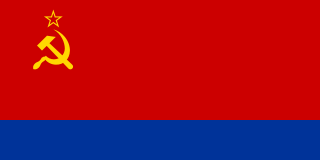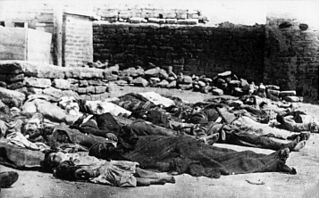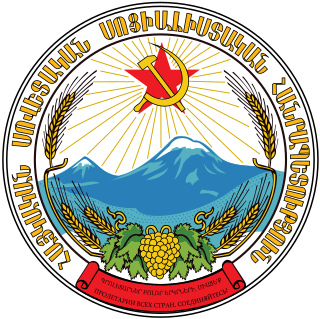
The Azerbaijan Soviet Socialist Republic, also referred to as the Azerbaijani Soviet Socialist Republic, Azerbaijan SSR, Azerbaijani SSR, AzSSR, Soviet Azerbaijan or simply Azerbaijan, was one of the constituent republics of the Soviet Union between 1922 and 1991. Created on 28 April 1920 when the Russian Soviet Federative Socialist Republic brought pro-Soviet figures to power in the region, the first two years of the Azerbaijani SSR were as an independent country until incorporation into the Transcaucasian SFSR, along with the Armenian SSR and the Georgian SSR.

The Democratic Republic of Georgia was the first modern establishment of a republic of Georgia, which existed from May 1918 to February 1921. Recognized by all major European powers of the time, DRG was created in the wake of the Russian Revolution of 1917, which led to the collapse of the Russian Empire and allowed territories formerly under Russia's rule to assert independence. In contrast to Bolshevik Russia, DRG was governed by a moderate, multi-party political system led by the Georgian Social Democratic Party (Mensheviks).

The Nakhichevan Autonomous Soviet Socialist Republic, abbreviated as Nakhichevan ASSR was an autonomous republic within the Azerbaijan SSR, itself a republic within the Soviet Union. It was formed on 16 March 1921 and became a part of the Azerbaijan SSR proper on 9 February 1924.

Sergo Konstantinovich Ordzhonikidze was a Georgian-born Bolshevik and Soviet politician.

The Azerbaijan Democratic Republic, also known as the Azerbaijan People's Republic, was the first secular democratic republic in the Turkic and Muslim worlds. The ADR was founded by the Azerbaijani National Council in Tiflis on 28 May 1918 after the collapse of the Transcaucasian Democratic Federative Republic, and ceased to exist on April 28, 1920. Its established borders were with Russia to the north, the Democratic Republic of Georgia to the north-west, the Republic of Armenia to the west, and Iran to the south. It had a population of around 3 million. Ganja was the temporary capital of the Republic as Baku was under Bolshevik control. The name of "Azerbaijan" which the leading Musavat party adopted, for political reasons, was, prior to the establishment of the Azerbaijan Democratic Republic in 1918, exclusively used to identify the adjacent region of contemporary northwestern Iran.

Nariman Karbalayi Najaf oghlu Narimanov was an Azerbaijani Bolshevik revolutionary, writer, publicist, politician and statesman. For just over one year beginning in May 1920, Narimanov headed the government of Soviet Azerbaijan. He was subsequently elected chairman of the Union Council of the Transcaucasian SFSR. He was also Party Chairman of the Central Executive Committee of the Soviet Union from 30 December 1922 until the day of his death.

The March Days or March Events was a period of inter-ethnic strife and clashes which took place between 30 March – 2 April 1918 in the city of Baku and adjacent areas of the Baku Governorate of the Transcaucasian Commissariat.

The Nagorno-Karabakh Autonomous Oblast (NKAO) was an autonomous oblast within the Azerbaijan Soviet Socialist Republic that was created on July 7, 1923. Its capital was the city of Stepanakert. The leader of the oblast was the First Secretary of the Nagorno-Karabakh Autonomous Oblast Committee of the Communist Party of Azerbaijan. The majority of the population were ethnic Armenians.

The Armenian-Azerbaijani war (1918–1920) was a conflict that took place in the South Caucasus in regions with a mixed Armenian-Azerbaijani population, broadly encompassing what are now modern-day Azerbaijan and Armenia. It began during the final months of World War I and ended with the establishment of Soviet rule.

The Red Army invasion of Georgia, also known as the Georgian–Soviet War or the Soviet invasion of Georgia, was a military campaign by the Russian Soviet Red Army aimed at overthrowing the Social Democratic (Menshevik) government of the Democratic Republic of Georgia (DRG) and installing a Bolshevik regime in the country. The conflict was a result of expansionist policy by the Russians, who aimed to control as much as possible of the lands which had been part of the former Russian Empire until the turbulent events of the First World War, as well as the revolutionary efforts of mostly Russian-based Georgian Bolsheviks, who did not have sufficient support in their native country to seize power without external intervention.

The Republic of Mountainous Armenia, also known as simply Mountainous Armenia, was an anti-Bolshevik Armenian state roughly corresponding with the territory that is now the present-day Armenian provinces of Vayots Dzor and Syunik, and some parts of the present-day Republic of Azerbaijan in the west. It was established by military commander and Armenian political thinker Garegin Nzhdeh and his allies with the support of local guerrilla forces, following the suppression of the February Uprising in April 1921. It was not recognized by any country but existed until mid-July of the same year.

The Battle of Baku took place in August and September 1918 between the Ottoman–Azerbaijani coalition forces led by Nuri Pasha and Bolshevik–ARF Baku Soviet forces, later succeeded by the British–Armenian–White Russian forces led by Lionel Dunsterville and saw Soviet Russia briefly re-enter the war. The battle took place during World War I, was a conclusive part of the Caucasus Campaign, but a beginning of the Armenian–Azerbaijani War.

Polikarp "Budu" Gurgenovich Mdivani was a veteran Georgian Bolshevik and Soviet government official energetically involved in the Russian Revolutions and the Civil War. In the 1920s, he played an important role in the Sovietization of the Caucasus, but later led Georgian Communist opposition to Joseph Stalin's centralizing policy during the Georgian Affair of 1922. He was executed during the Great Purge.

Alexander Fyodori Miasnikian or Myasnikov, also known by his revolutionary nom de guerreMartuni, was an Armenian Bolshevik revolutionary, military leader and politician. During the Russian Civil War, he served as First Secretary of the Communist Party of Byelorussia from 1918 to 1919. As the Chairman of the Council of People's Commissars of Armenia from 1921 to 1922, he is credited with rebuilding the Armenian republic at the beginning of Lenin's New Economic Policy (NEP).

The Communist Party of Armenia was a branch of the Communist Party of the Soviet Union within the Armenian SSR, and as such, the sole ruling party in the Armenian SSR.

Khosrov bey Alipasha bey oghlu Sultanov, also spelled as Khosrow Sultanov, was an Azerbaijani statesman, General Governor of Karabakh and Minister of Defense of the Azerbaijani Democratic Republic.

The Red Army invasion of Azerbaijan, also known as the Sovietization or Soviet invasion of Azerbaijan, took place in April 1920. It was a military campaign conducted by the 11th Army of Soviet Russia with the aim of installing a new Soviet government in the Azerbaijan Democratic Republic. This invasion occurred simultaneously with an anti-government insurrection organized by local Azerbaijani Bolsheviks in the capital city of Baku. As a result of the invasion, the Azerbaijan Democratic Republic was dissolved, and the Azerbaijan Soviet Socialist Republic was established.

The May Uprising was a coup d'état attempt by the Armenian Bolsheviks that started in Alexandropol on May 10, 1920. It was eventually suppressed by the Armenian government on May 14 and its leaders executed. Although the revolt failed, Armenia was taken over by the soviets after the 11th Army of Soviet Russia invaded the country in November 1920 and the Turkish Nationalists occupied the western half of the country. The revolt and its executed leaders were praised during the Soviet period from 1920 until the late 1980s, when the Karabakh movement began and anti-Soviet sentiment rose in Armenia – The revolt remains a controversial topic in Armenia.

The Red Army invasion of Armenia[a] was a military campaign which was carried out by the 11th Army of Soviet Russia from September to 29 November 1920 in order to install a new Soviet government in the First Republic of Armenia, a former territory of the Russian Empire. The invasion coincided with two concurrent events, the Turkish invasion, as well as the anti-government insurrection which was staged by the local Armenian Bolsheviks in the capital, Yerevan, and other cities and populated places within the country. The invasion led to the dissolution of the First Republic of Armenia and the establishment of the Armenian Soviet Socialist Republic.
Avis (Avetis) Soghomoni Nurijanyan was a Bolshevik revolutionary and Soviet politician of Armenian origin who served as the People's Commissar for Military Affairs of the Armenian SSR from 1920 to 1921 and People's Commissar for Internal Affairs in 1921. He is infamous for his role in carrying out mass repressions immediately following the Sovietization of Armenia.



















